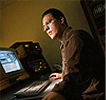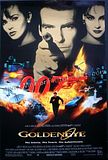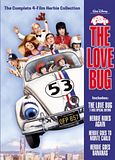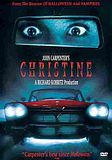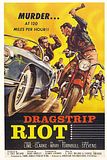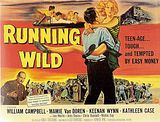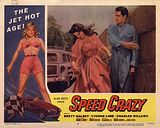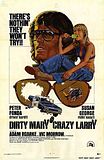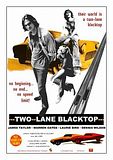Hot Rod Movies
Hot-rod hoodlums: the best - and worst - of early car movies
by Matt Stone
Motor Trend, January, 1998 No. 1, Vol. 49; Page 80
The phrase "cars and the movies" has almost as much of a show-business ring as "light, cameras, action." From Laurel and Hardy and the Keystone Kops, to "Goldfinger," "Goldeneye," and "The Solid Gold Cadillac," automobiles have served as major plot elements since the beginning of film making. And if an automobile just happened to be the right car at the right time, like Herbie the Love Bug or Steven King's Christine, it just might score a leading role.
The cars-on-screen theme has taken many shapes throughout the history of film, from the serious to the sublime, and sometimes the sensational. But a unique genre of spectacularly marginal filmmaking sprouted up just after World War II. These low-budget barnstormers centered around hot cars, cool music, and a rebellious American youth with a need for independence and expression. Call them what you will: "hot-rod flicks" or the more philosophical "exploitation films," they started showing up around 1950. By the middle of that decade, the typical low-budget, no-name-actor, hot-cars-and-fast-girls movie was being churned out of Hollywood's backlots at the rate of about one per week. The fervor raged for over 10 years, until the increasingly violent and graphic biker films gave nervous parents a new, more serious reason to keep their teen-agers in at night.
The tastiest of the breed were the numerous "B"-rated black-and-whiters of the now-so-nostalgic '50s and early '60s. You know, the ones with names like "Hot Rod Girl" and "Dragstrip Riot." Remember such pearls as "Running Wild" and Speed Crazy"? Most titles had "Hot," "Rod," "Dragstrip," "Car," or "Girl" contained in them somewhere. "They were the automotive versions of gunfighter themes," says Tim Considine, a child-actor-turned-writer who played Spin on the Mickey Mouse Club's series, "The Adventures of Spin & Marty." Considine was a part of Hollywood car and movie circles at an early age; he remembers with great fondness these films and the people who made them.
"There were the good guy, the bad guy, and the girl--and the girl was probably second [in importance] to the car, just as the girl was second to the horse in the cowboy movies."
The plots were generally simple: a story, one or more conflicts, a showdown, the good guy wins, the bad guy loses (and sometimes dies in the process), and the good guy gets the girl. Instead of a gunfight at the OK Corral, the resolution of the plot often came down to the proverbial "chicken race" on a deserted mountain road.
Considering that both the film industry and hot rodding were born in Southern California, it's no surprise that Hollywood and its surrounding communities served as backdrop for so many of these films. While a set may have been built for use as a diner or garage, most of the location work was done at the places hot rodders and their cars could be found: Griffith Park, the dragstrip at the Pomona Fairgrounds, or the desolate roads of the yet-undeveloped San Fernando Valley. These movies were most often the products of small studios and independents, and the filmmaking craft was marginal, even by standards of the day.
At the beginning of this era, which automotive film expert Ron Main considers to be the making of "Devil on Wheels," in 1947, there was no such thing as a purpose-built "movie car." The "bombs" and "jobs" were some of So-Cal's most memorable early hot rods and customs: T-buckets powered by full-house flatheads, Model As with "nailhead" Buicks, a chopped Barris Merc, and so on. There's a scene in "Dragstrip Girl" where Fay Spain (who's "Car Crazy!...Speed Crazy!...Boy Crazy!...," according to the poster) drives her hot rod into a garage where several characters are working on their cars. The assemblage in that little filling station shop would have easily filled the period hot rod class at last year's Pebble Beach Concours d'Elegance.
Most of the actors were locals, and many were never heard of before - or since, though there are a few notable exceptions. Watch enough of these films, and you'll see a vivacious Mamie Van Doren or Connie Stevens, a young Chuck Connors or Doug McClure, and a somewhat Jim Carrey-like Frank Gorshin, long before he became known as The Riddler on TV's "Batman." Some, like Norm Grabowski, were real-life L.A. hot rodders who were on the set with their cars and ended up becoming actors almost by accident. Others, like "TV Tommy" Ivo, initially got involved as legit actors, but were hooked by the appeal of hot rodding and racing.
"I started acting in pictures when I was seven years old," the now-retired actor and pro drag racer told Motor Trend. "I did it for nineteen years. I was in Southern California, where drag racing got its start, and when you got a car, you took it down to the strip to see what it would run."
"Just for something to do in between pictures, I fiddled around with cars. It was just a natural step when they started doing these car pictures, for me to act and use some of my cars in them." True, many of Ivo's own hot rods and innovative race cars made it onto film. As hot rods developed into purpose-built rail dragsters, Ivo traded his acting career for a life in professional drag racing, retiring with several NHRA national wins under his belt.
An almost necessary plot element was some sort of confrontation with the law. As we know from the development of organized drag racing and the birth of the NHRA, many politicians and police departments were feverishly trying to get racing off the streets. That need often appeared as an underlying theme. The hoodlum element was played upon as the young hot rodders resisted the establishment, usually breaking the law in the process.
While today's Gen-Xers are often defined as the ultimate image-seeking group, these films are simply dripping with posturing.
"It was just part of being cool," comments Main. "You watch a John Wayne movie, you want to be like John Wayne. Being tough, being cool. [The films] were a cross between John Wayne and hot rods... it was part of our group, our badge." Adds Ivo, "It was exaggerated a bit for the movies... they take artistic license with this stuff... but it was based on fact."
The genre continued well into the '60s and '70s, as outcast films dike "Dirty Mary, Crazy Larry," "Two Lane Blacktop," and the comedically friendlier "Smokey and the Bandit" represented variations on the theme. Even beach-blanket legends Frankie Avalon and Annette Funicello got into the act with car-augmented movies like "Bikini Beach Party," while maturing leading actors Dana Andrews and Jeanne Crain allowed themselves to be terrorized by sweater-clad toughs in a '58 Vette in MGM's "Hot Rods to Hell."
The very best of the breed? It has to be "Rebel Without a Cause." Has there ever been a cooler dude than the great James Dean? But then again, that Paramount masterpiece had a star cast, a decent budget, and a complex, well-developed plot. In truth, the essence of the great "B" exploitation films was in those low-budget, '50s to early '60s works that somehow capture the spirit of hot rodding, the troubles of a McCarthy-era youth culture, and its not so latent desires for fun, freedom, and speed.
Interested in learning more about these and other car-flavored films? Check out the book "Races, Chases & Crashes," by Ron Main, available from Motorbooks Publishing at 1-800-826-6600. You can also get the book and a catalog of available movies through Main Events, P.O. Box 4923, Chatsworth, CA 91313.
1998 Petersen Publishing Company, Motor Trend
